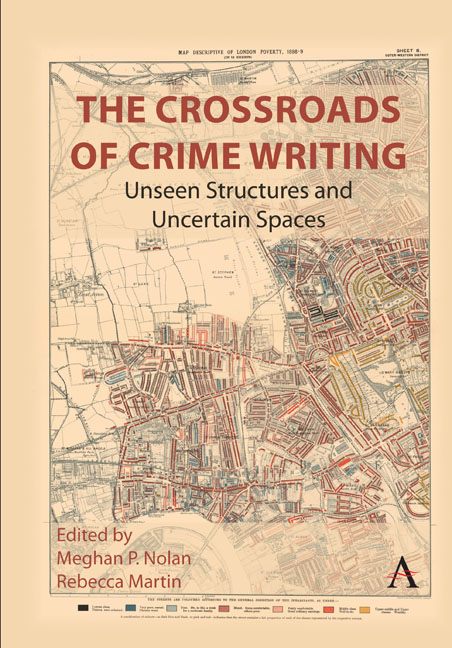Book contents
- Frontmatter
- Contents
- Introduction
- Unseen Structures
- Chapter 1 Unseen Structures and the Outlaw: Depictions of Violations in Stieg Larsson’s Millennium Trilogy
- Chapter 2 Dark Waters: Eco-Noir in New York 2140
- Chapter 3 Between Lenin and Sherlock Holmes: Soviet Militsiya Procedural in Volodymyr Kashin’s Detective Fiction
- Chapter 4 Detecting Justice: Black Crime Fiction and the Novels of Attica Locke
- Chapter 5 The Police and the Private Eye: The Making of Gendered and Racial Peripheralization in the Crime Fiction of Valerie Wilson Wesley
- Uncertain Spaces
- Chapter 6 Navigating the Carceral City: Calcutta in Late Nineteenth-Century Narratives of Detection
- Chapter 7 Traversing the Borders of Poverty and Morality: The Intersection of Maps and Upper-Class Ethics in Anne Perry’s Neo-Victorian Series
- Chapter 8 Facts and Fictions: The Liminal Space Between True Crime and Crime Fiction
- Chapter 9 The Success(Ion) and Corruption of Crime Genres in Jo Nesbø’s Macbeth (2018)
- Chapter 10 The Golden Age Meets the Age of Aquarius: Agatha Christie in the 1960s
- Notes on Editors and Contributors
- Permissions
- Index
Chapter 6 - Navigating the Carceral City: Calcutta in Late Nineteenth-Century Narratives of Detection
Published online by Cambridge University Press: 13 April 2024
- Frontmatter
- Contents
- Introduction
- Unseen Structures
- Chapter 1 Unseen Structures and the Outlaw: Depictions of Violations in Stieg Larsson’s Millennium Trilogy
- Chapter 2 Dark Waters: Eco-Noir in New York 2140
- Chapter 3 Between Lenin and Sherlock Holmes: Soviet Militsiya Procedural in Volodymyr Kashin’s Detective Fiction
- Chapter 4 Detecting Justice: Black Crime Fiction and the Novels of Attica Locke
- Chapter 5 The Police and the Private Eye: The Making of Gendered and Racial Peripheralization in the Crime Fiction of Valerie Wilson Wesley
- Uncertain Spaces
- Chapter 6 Navigating the Carceral City: Calcutta in Late Nineteenth-Century Narratives of Detection
- Chapter 7 Traversing the Borders of Poverty and Morality: The Intersection of Maps and Upper-Class Ethics in Anne Perry’s Neo-Victorian Series
- Chapter 8 Facts and Fictions: The Liminal Space Between True Crime and Crime Fiction
- Chapter 9 The Success(Ion) and Corruption of Crime Genres in Jo Nesbø’s Macbeth (2018)
- Chapter 10 The Golden Age Meets the Age of Aquarius: Agatha Christie in the 1960s
- Notes on Editors and Contributors
- Permissions
- Index
Summary
Introduction
As the capital of the British Empire in India, Calcutta (Figure 6.1) in the nineteenth century was a bustling metropolis that housed important administrative, commercial, and cultural centers of the colonial government. However, all was not well in this “city of palaces.” Contemporary accounts in both English and Bengali testify to the ubiquity of crime and illegal activities in the city. Criminals negotiated the space of the city and its infrastructure in novel ways, giving rise to heterogeneities that challenged the logic of the per-fectly organized, disciplined city that the colonial administration wanted to approximate. There was an insidious battle for the space of the colonial city, and the stakeholders—the victims, the criminals, the police, and the detectives—were all implicated.
In the history of Calcutta, the year 1868 would be noteworthy for a few reasons. It was the year when the colonial government brought into force the Contagious Diseases Act (CDA). Under this law, sex workers were expected to get registered with the colonial government on the one hand and undergo compulsory checkups for venereal diseases on the other. The same year saw the inauguration of the detective department of the Calcutta Police. These two interventions on the part of the colonial government exemplified a con-solidation of the stranglehold of colonial discipline over urban space. As such, they facilitated greater surveillance and control over the subject population. Though the CDA was repealed in 1888 after protracted opposition from several social groups, the detective department continued to flourish. Simultaneously, the late nineteenth century witnessed the inception of detective fiction in Bengali. These were anticipated by semi-autobiographical accounts penned by both European and Indian employees of the police. A close analysis of some of these texts reveals fascinating intersections and interactions between urban space, colonial discipline, and the act of detection.
This chapter attempts a spatial analysis of some of these texts, more specifically, the semi-autobiographical accounts penned by two employees of the detective department of Calcutta Police. Its focus lies in the production of what Henri Lefebvre calls social space and its production through various social processes.
- Type
- Chapter
- Information
- The Crossroads of Crime WritingUnseen Structures and Uncertain Spaces, pp. 127 - 152Publisher: Anthem PressPrint publication year: 2024

